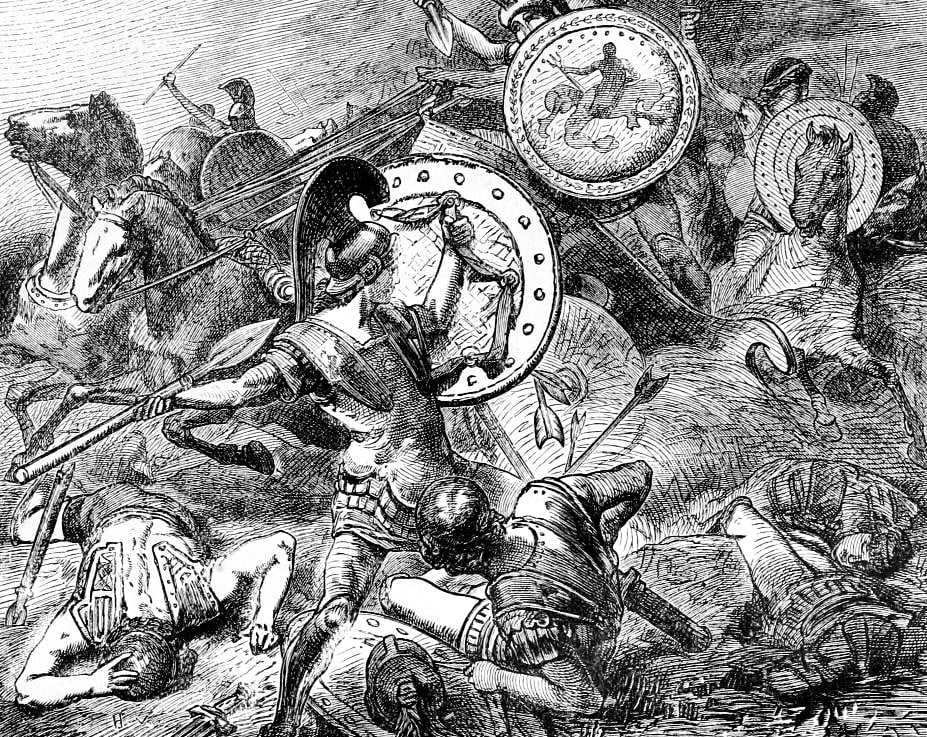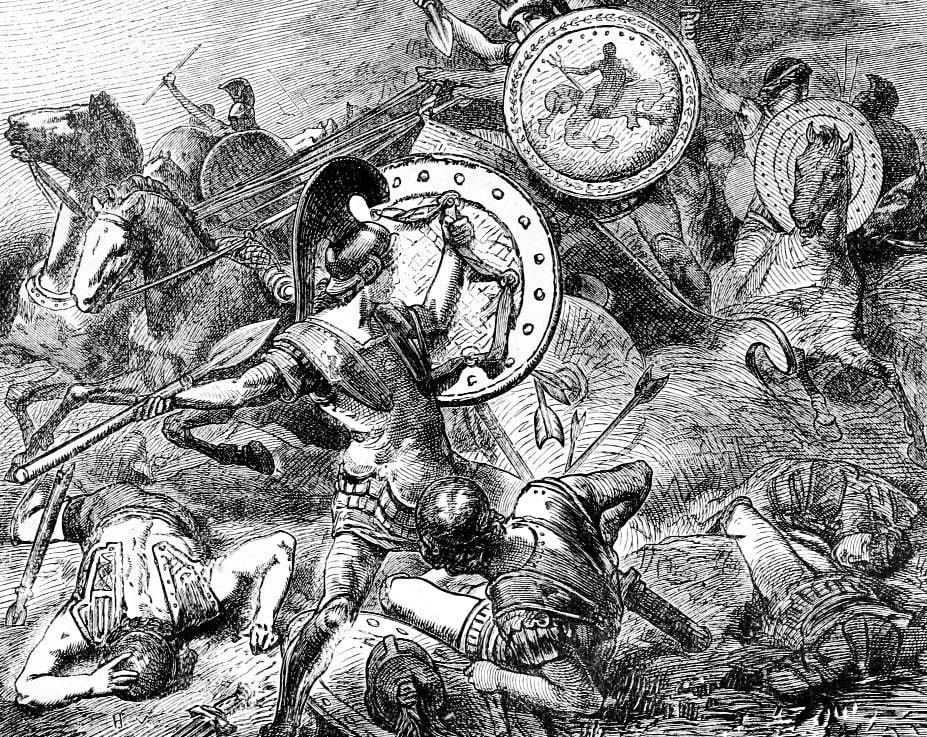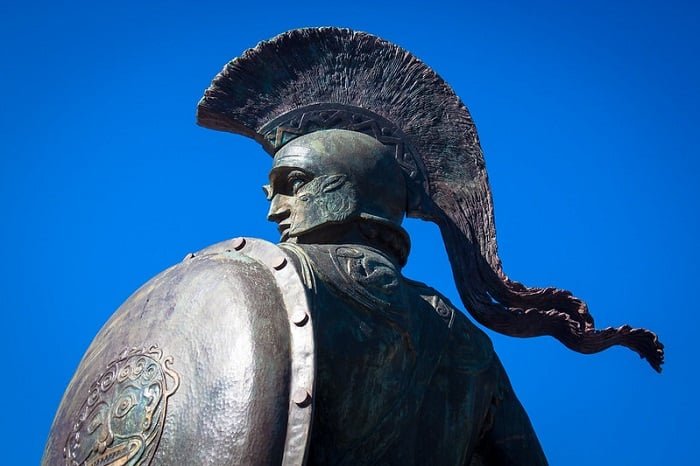
Epaminondas was a general and statesman who beat the Spartans and, for a short period in 4th century BC, made Thebes the greatest power of ancient Greece.
Thebes is a city in Boeotia in Central Greece. In ancient times, it was steeped in mythology. Heracles, Dionysus, and Oedipus, for instance, are mythological figures who originated from Thebes. Cadmus was the most important of these. He was the founder of the city, its first king, and the man who brought the Phoenician alphabet to Greece from where it was adopted by much of the world.
Archaeological remains of Thebes date to a thousand years from the end of the Early Helladic II period (c. 2100 BC) to the end of the Bronze Age (c. 1200 BC). It was during this time that Thebes grew from a small community to one of the largest cities of Greece.
Excavations have shown that its prehistoric remains were buried deep down and were relatively well preserved. Its extensive fortifications with seven gates are evidence of its importance during the Bronze Age. Archaeological findings also show that the site was once a Mycenaean settlement. Clay tablets with Linear B script speak to the significance of the area in antiquity.
Thebes was the leader of the Boeotian League, established around 550 BC. In the 5th century BC, Thebes rivaled Athens in power. According to Herodotus, in the second Persian invasion, the Thebans sided with the Persians. Modern historians argue they supported Athens. Herodotus exaggerated the neutral stance of Thebes, which was against joining Athens and Sparta in the war against the invaders.
For a brief period in the 4th century BC, Thebes became the dominant city-state in Greece after beating Sparta twice in battle, ending its military dominance. This was essentially because of two great men, namely Epaminondas and his dear friend Pelopidas.
Epaminondas before his rise in power
Epaminondas was born to a rich family between 419 and 411 BC. His father, Polymnis, offered his son a high quality education in private schools. He was taught philosophy by Lysis of Tarentum, a Pythagorean who had lived in Magna Graecia—Sicily and other Greek colonies in southern Italy—and had been allowed to settle in Epaminondas’ father’s own house.
Lysis was significantly influential on Epaminondas, who was devoted to his older teacher. He embraced his Pythagorean philosophy. As a young man, he displayed all the virtues a young man of his times would aim to possess, including selflessness, idealism, incorruptibility, patriotism, and modesty. His independence was especially important to him. He thus aimed to lead an austere life.
What Epaminondas really excelled at was military strategy. He was also quite eloquent but also laconic, witty, and humorous. He never married, but his friendship with his lifelong companion, Pelopidas, became legendary.
In 385 BC, Epaminondas served in a Theban military detachment that fought alongside the Spartan forces against a coalition of Athenians, Mantineians, and Argives at Mantineia on the Peloponnese. According to Plutarch, Pelopidas suffered seven wounds in battle, and Epaminondas saved his life.
This was the beginning of their friendship. According to other sources, they knew each other prior to the battle and had a common ambition. This was the establishment of Thebes as a great power in ancient Greece. Plutarch writes they ruled together for twenty years.
Thebes in the Corinthian War
In 395 BC, the Corinthian War broke out, as Sparta’s allies, Corinth and Argos, in the Peloponnesian War (431-404 BC) were dissatisfied. This was because they had not been acknowledged, and Sparta had exhibited an imperialistic attitude following its victory. Thebes joined its former rival—Athens, the defeated side of the conflict—along with Corinth and Argos against Sparta.
At the time war was declared, Sparta, led by Agesilaus was in Asia Minor fighting the Persians in an effort to liberate Ionia. Both sides suffered great losses, but there was a clear winner. Only Athens benefited because the Persian ships had destroyed Sparta’s fleet.
Seeing Athens regain its naval power, Persian King Artaxerxes II intervened. Siding with Sparta, he ordered the King’s Peace, ending the war. The clause stated Greek cities were prohibited from forming alliances, coalitions, or leagues. They would thus remain “autonomous.” Sparta was to guard the conditions of that peace treaty.
Some Spartan generals took advantage of the peace conditions and acted arbitrarily. One of these, Phoebidas, seized the Theban acropolis of Cadmea. This was in violation of the King’s Peace. He appointed the oligarch Leontiades as one of the rulers. The event infuriated the democratic Thebans, and in 378 BC, they revolted against the Spartans.
The revolt of Thebes
It was Epaminondas who orchestrated the Theban revolt and Pelopidas who took the first steps that led to the Boeotian Wars of Thebes against Sparta in 378 BC. Along with a group of men, Pelopidas assassinated Leontiades and the rest of the oligarchs. The Theban democrats appointed Pelopidas Boeotarch, and, with his men, they sieged the Spartan garrison in Cadmea.
The Spartans reacted immediately and sent troops to Thebes under King Agesilaus II. Cadmea was surrounded, but the Thebans had already set a blockade around the city, making the Spartans reluctant to attack, so they turned back. This encouraged the Thebans under the strong leadership of Epaminondas and Pelopidas. They undertook operations in neighboring cities and reformed the Boeotian League.
Several Spartan attempts to attack Boeotia and reach Thebes failed. With Epaminondas and Pelopidas at the helm, the power of Thebes was growing. An attempt to revive the King’s Peace also failed.
The Battle of Leuctra
In 371 BC, Spartan King Cleombrotus demanded the disbandment of the Boeotian League and received a resounding negative response by Epaminondas. Cleombrotus amassed an army of 2,000 men, 700 of them being Spartan citizens. Of these, 9,000 were allied troops, and of the 11,000 total men, 1,000 were cavalry. The Spartans marched onwards to Boeotia.
Thebes, on the other hand, lined-up 7,000 hoplites, 300 of which were the Sacred Band of Thebes, an elite force of 150 homosexual couples sworn to fight to death for each other in battle. They were led by Pelopidas. There was also an elite cavalry force of 600 men.
The two armies met at Leuctra, where Epaminondas utilized his ingenious strategy that perplexed the Spartan general. The Theban general put his cavalry and light-infantry in front of his own phalanx formation. Instead of the conventional tactic to make the right wing the strongest, he made his left wing extraordinarily deep. It was composed of 50 ranks of men. This made his lines narrower than the Spartans. The Sacred Band was also positioned on the left wing with the Boeotian allies being stationed on the right wing about 8 to 12 men deep.
Cleombrotus was forced to reorganize his formation to respond, but that exposed his immediate left side, and as the Spartan cavalry were no match for the Thebans who soon routed them, the Spartan horsemen were forced back onto their own lines and through the gap which had opened on Cleombrotus’ left. The Thebans followed them through this gap and created chaos in the Spartan formation.
Meanwhile, Epaminondas attacked at an angle towards the left Spartan side. In effect, Cleombrotus was pushed away from his own line. Epaminondas’ attack was also conducted with his own right wing slightly in arrears in an echelon formation to protect his own exposed flank as he attacked the Spartan cavalry. Simultaneously, Pelopidas and his Sacred Band attacked on Cleombrotus’ side and killed the Spartan king, concluding the defeat of the Spartans.
Thebes rises to the top of ancient Greece
The aftermath of the Battle of Leuctra left the Spartans feeling humiliated. The military hegemony of Sparta was crushed in the Boeotian field. Thebes, under the leadership of Epaminondas and Pelopidas, the two most capable men who ever assumed the leadership of that city, rose to the top. For the first and only time in Greek history, Thebes, the dominant city in the region of Boeotia, became the master of all of Greece.
The Theban hegemony continued in the following years, as previous allies of Sparta switched alliances and joined Thebes. Athens asked Thebes to a peace conference, but Epaminondas refused. Thebes now had the backing of Persia and was too powerful to accept. Hence, it continued its expansion.
In the 360s, Pelopidas led a few campaigns in Thessaly and Macedonia so as to form new alliances. In 364 BC, he received an appeal from Thessalian towns against the tyrant Alexander of Pherae. He marched with few troops but managed to overthrow the tyrant’s force. Wishing to kill the tyrant with his own hand, he was slain by his guards.
In the same decade, Epaminondas led several campaigns throughout the Peloponnese with the ultimate goal of conquering Sparta. Sparta was forced to ally with arch rival Athens to fight the rising power. In 362 BC, the Spartan and Athenian armies met the army of Epaminondas in the Battle of Mantineia.
Death and the aftermath
According to Cornelius Nepos, the Spartans had deliberately concentrated their efforts on assassinating Epaminondas so as to demoralize the battling Thebans. During battle, they managed to strike him on the chest with a spear, and his men fought desperately to protect him. They took him to camp alive.
According to Diodorus, one of his friends exclaimed: “You die childless, Epaminondas” and cried. In response, Epaminondas is said to have replied “No, by Zeus, on the contrary I leave behind two daughters, Leuctra and Mantinea, my victories.”
According to Cornelius Nepos, the last words of Epaminondas were: “I have lived long enough; for I die unconquered.” When the spear point was withdrawn, Epaminondas promptly died. His men buried him on the battlefield, as was customary for Greeks who died in battle.
Following his death, Epaminondas’ successors did not match his political or military skills, and Thebes’ hegemony in ancient Greece quickly diminished.


